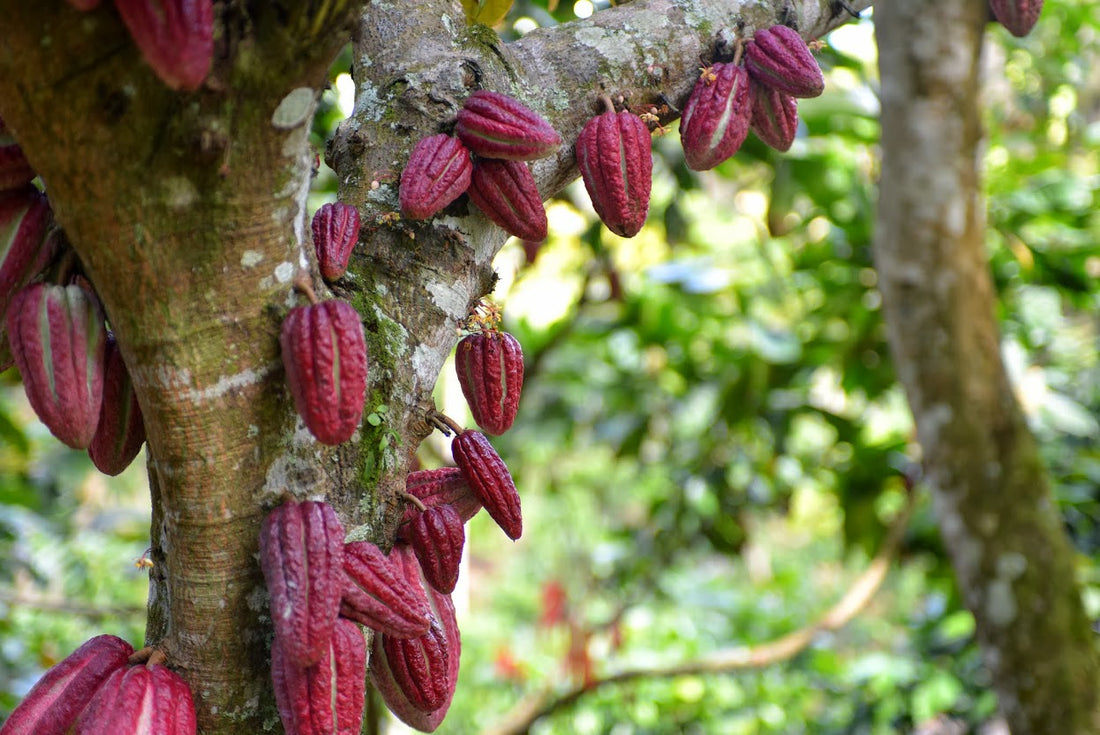
Cocoa Bean Varietals
Share
Theobroma cacao is a tree that thrives in the equatorial regions of Central and South America, Africa, and Southeast Asia at an altitude up to 2,000 meters above sea level.
These trees cannot withstand extremely dry or excessively wet periods. Rainfall should be regular and between 50-100 inches per year. Susceptible to strong winds and direct sunlight, cacao trees grow best with the shade and protection of surrounding, tall-growing plants and trees. Soil should be fertile, slightly acidic, and well drained. However, some moisture retention is needed during drier times.
Cacao trees on farms or estates are kept at a height of 13-25 feet (4-8 m) but can grow as tall as 40-50 feet (12-15 m) in the wild. The cocoa tree blooms and bears fruit the whole year round.
Fully grown cacao pods vary in shape, color, texture, size, and can range from 5-12 inches length. A ripe fruit may contain 20 to 75 cocoa beans, each .5-1.5 inches long and encased in a white pulp. Beans are roughly 50% fat and 25% carbohydrates. Nutritionally, cocoa contains proteins, theobromine, niacin, minerals (including calcium, iron, potassium, magnesium, sodium, and phosphorus) and vitamins A, B1, B2 and B6.
There are four main genetic variants of cocoa beans: Criollo, Forastero, Trinitario, and Nacional.
- Criollo
- The Criollo trees are found in Central and South America, Caribbean islands, and Sri Lanka. Criollos are highly vulnerable to a variety of environmental threats making them difficult to grow. The beans have a white to pale pink color. Their taste is described as delicate yet complex, low in classic chocolate flavor, but rich in secondary notes of long duration. Making up only 1%-5% of total crop production across the world, Criollo is prized as an ingredient in the very finest of chocolates.
- Forastero
- With native origins from the Amazon basin, this is now the most widely grown bean, about 80% of all cacao production. It’s grown in Brazil, Ecuador, and Africa. These trees are hardier, less susceptible to disease, and provide a much higher cacao yield than Criollo. Forastero cocoa has purple-coloured beans and is mainly used to give chocolate its full-bodied flavor.
- Trinitario
- Cross-pollination developed Trinitario as a hybrid of Criollo and Forastero originating in Trinidad. Trinitario offers the growing hardiness of Forastero with the refined flavors of Criollo. Very aromatic with additional characteristics between the Criollo and Forastero varieties.
- Nacional
- A rare variety found in Ecuador, Peru, and parts of South America. These beans are rich, creamy, and offer little bitterness.
- Additional Genetic Clusters
- Amelonado, Contamana, Curaray, Guiana, Iquitos, Marañon, Nanay, and Purús
Parts of Cocoa Fruit
- Cocoa Bean: Seed of the cocoa fruit containing episperm (or integument), embryo, and cotyledon
- Cocoa Pod: Cocoa fruit pericarp forming around the ripened ovary wall
- Episperm/Integument: Protective layer of the seed, also called the shell when dried
- Pulp: Mucilaginous and acidic substance coating the seeds
- Radicle: Dense, stem-like would have become the tap root for the new cocoa tree if the bean had been left to grow.

